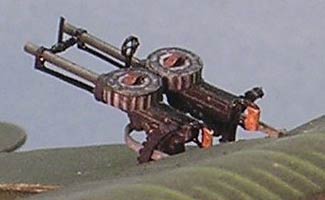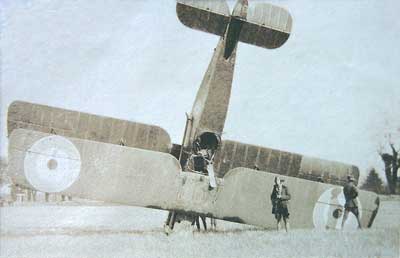



Bristol F-2B Brisfit

The WWI Bristol F2b 'Brisfit' Fighter was the most successful
two-seat fighter of World War I, and was built to the  extent of
4,470 aircraft between 1916 and 1926. It's included in the World's
Smallest Air Museum collection because of that importance. Take
care to understand the wing joining at the fuselage.
extent of
4,470 aircraft between 1916 and 1926. It's included in the World's
Smallest Air Museum collection because of that importance. Take
care to understand the wing joining at the fuselage.
In 1917, the Bristol F2b Fighter was a very misunderstood airplane. On 5 April, six Bristol two-seater fighters of No 48 Squadron took off on the aircraft's first operational mission. Only two returned. Near Dubai the Bristol Fighters had been attacked by five Albatros DIIIs, the aircraft they had been designed to fight against. But conventional two-seater tactics were hopelessly inadequate against the hard-hitting Germans.

The BRISTOL 'BRISFIT' model by Dick Doll
The F2-B Brisfit model is one of the more challenging of models but just look at what kind of model is possible!! Kudos to Dick Doll for this masterpiece. He writes:
"The cockpit has a seat and a joystick; it is armed
with twin Lewis', made from a paperclip, an "O" ring and
scrap plastic & wood - it also has a single Vickers. The
rigging is thread and the control rods are small dia. brass
rods. I put on the more powerful 4-blade prop. It has the
shock absorber tailskid. Notice the rusted exhaust ."
Bristol F.2b

In 1917, the Bristol 'Brisfit' WWI Fighter was a very misunderstood airplane. On 5 April, six Bristol two-seater fighters of No 48 Squadron took off on the aircraft's first operational mission. Only two returned.
Near Dubai the Bristol Fighters had been attacked by five Albatros DIIIs, the aircraft they had been designed to fight against. But conventional two-seater tactics were hopelessly inadequate against the hard-hitting and highly maneuverable Albatros scouts. These ditatted that the observer's Scarf-mounted Lewis gun was the main armament, with the fixed forward-firing Vickers used by the pilot as secondary or emergency armament.
That morning, Manfred von Richthofen and four of his crack pilots from Jagdgeschwader I proved in the most dramatic way possible that the rear cockpit gunner was no match for a diving attack. Some urgent re-thinking was needed if the Bristol Fighter was not to become one of the greatest flops of the war.
Suddenly the pilots appreciated the fact that the two-seat Bristol Fighter was as fast and very nearly as maneuverable as the single-seat Scouts which were much smaller. And that it could be thrown around the sky just like a single-seater. So the Bristol Fighter pilots went on the offensive and started to fly their airplanes using conventional single-seat tactics, twisting and turning to get above and behind their opponents (or away from them), and leaving the observer to protect the rear. This tactic was immediately successful and brought to a halt that fateful period for the Allies known as 'Bloody April'.
T he Bristol F.2 was designed by Captain Frank Barnwell of the
British & Colonial Aeroplane Company. His aim had been to
replace the aging BE-2s that were such easy targets for the German
fighters.
he Bristol F.2 was designed by Captain Frank Barnwell of the
British & Colonial Aeroplane Company. His aim had been to
replace the aging BE-2s that were such easy targets for the German
fighters.
Barnwell's early design in March 1916 would have been powered by the 120 hp Beardmore. However, at that time Rolls-Royce brought out the much more powerful Falcon I, which could develop 190 hp. Barnwell recognized that this extra power would transform his design from a reconnaissance aircraft to a two-seater fighter.
The Bristol F.2A made its first flight on 9 September 1916, and by March 1917, the first aircraft was delivered to front-line squadrons. The F.2A was quickly followed by the F.2B, which had a slightly larger tailplane, some structural changes to the wings and improved cockpit vision. The F.2B received unrated versions of the Rolls-Royce Falcon. The Falcon II developed 220hp, but this was quickly followed by the 275hp Falcon III. With this engine, the RFC pilots found they had a magnificent fighting tool.
This change in the Bristol's fortunes was no small surprise to 'the Hun'. On its first disastrous commitment to battle the new two-seater was closely watched by none other than Manfred von Richthofen, who reported that the Albatros DIII was in all aspects of performance 'undoubtedly superior'. The new Bristol, instantly identified by its fuselage mid-way between the wings, was mentally written off as what a later generation of pilots would have called 'a piece of cake'.
Then it suddenly became not merely aggressive but aggressive at both ends, twisting and turning and pumping out lead to targets at front and rear. The crews of these big two-seaters were in the summer of 1917 among the fastest scorers on the Western Front. For example, Capt McKeever and his observer scored almost all their 30 confirmed victories while still flying the original F-2A. Indeed, the Bristol was soon held in such respect that, except for the very top crack' circuses, it became a general rule for German pilots never to attack a formation of more than three Bristols, no matter how great their own numerical advantage might be.
With the Falcon III engine the RFC found they had not only all
the power they wanted but sweet run ning and unsurpassed reliability,
They were moved, as never before, to write poetry about the sheer
joy of flying such a fine machine. At last, it mattered little
whether the observer had one gun or. as was usually the case,
two - together with as many as eight massive 97-round drums of
ammunition, which had to be changed with frozen fingers whilst
the Fighter might be flung into a tight turn. Hanging a dozen
20-lb bombs under the lower wing was also no problem, though most
of the Bristol's countless missions were various kinds of 'offensive
patrol' without seeking surface targets as well.
ning and unsurpassed reliability,
They were moved, as never before, to write poetry about the sheer
joy of flying such a fine machine. At last, it mattered little
whether the observer had one gun or. as was usually the case,
two - together with as many as eight massive 97-round drums of
ammunition, which had to be changed with frozen fingers whilst
the Fighter might be flung into a tight turn. Hanging a dozen
20-lb bombs under the lower wing was also no problem, though most
of the Bristol's countless missions were various kinds of 'offensive
patrol' without seeking surface targets as well.
At one stage production of F-2B airframes outstripped the number of Falcon Ill engines and, because the need for the Bristol Fighters at the Front was so urgent, several hundred airframes were fitted with the 200hp Sunbeam Arab engine.
One pilot, Major Oliver Stewart wrote, 'The pilot could enter
a dogfight and turn almost as quickly and on almost as small a
radius as the best single-seater. He could fling his machine about,
go into vertical dives, pull it out quickly, turn it on its back,
spin it, roll it and generally do every sort of maneuver if the
need arose. And all the time there was the comfortable feeling
that the observer was there with his pair of Lewis guns, watching
and protecting.
Oliver Stewart wrote, 'The pilot could enter
a dogfight and turn almost as quickly and on almost as small a
radius as the best single-seater. He could fling his machine about,
go into vertical dives, pull it out quickly, turn it on its back,
spin it, roll it and generally do every sort of maneuver if the
need arose. And all the time there was the comfortable feeling
that the observer was there with his pair of Lewis guns, watching
and protecting.
Being Major Stewart's observer, however, cannot have been much fun. In fact, the observer's role in all two-seaters was one of the most heroic of the entire war. They had no engine to protect them and they were defenseless against enemy fire; their only protection being their gun. Yet there was no lack of volunteers for the job and indeed they were better off in a Bristol than in anything else.
By the end of the war, 14 squadrons were flying the Bristol Fighter popularly known as the 'Brisfit' or 'Biff'. Unlike most other Allied aircraft it had stayed in production. It is a tribute to Barnwell's design that Bristol F.2s were produced long after the end of World War I and they were still flying in service with the Royal Air Force in 1932.
  These photos were sent in by Dr John Glessner-He likes to reduce his models to about 144 scale. This model has a wing span of about 6 inches!! |
 |
 |
 |
The upper R.H. picture is a close up of the complex landing gear that only the British would create. To make your wheels a little fatter, you can glue the paper wheel disks over buttons of the same size. |
|

Specifications for the Bristol F2b "Brisfit"
 |
Crew: 2 (pilot & observer/gunner) Length: 25 ft 10 in Wingspan: 39 ft 3 in Height: 9 ft 9 in Wing area: 405 ft² Empty weight: 2,145 lb Max takeoff weight: 3,243 lb Powerplant: 1× Rolls-Royce Falcon III liquid-cooled V12 engine, 275 hp Performance Maximum speed: 123 mph at 5,000 ft Range: 369 mi Service ceiling: 18,000 ft Rate of climb: 889 ft/min Armament Guns: 1× .303 in (7.7 mm) forward-firing Vickers machine gun in the upper fuselage 1 or 2× .303 in Lewis Guns in the observer's cockpit Bombs: 240 lb |
 |
Bristol F2b Fighter D2867 after forced landing by H.J. Crews, March 8, 1919 at Tetbury Aerodrome. |





